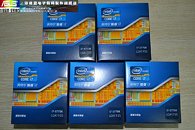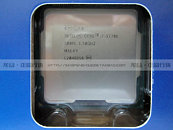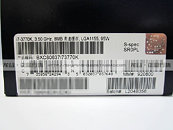Wednesday, April 18th 2012

Core i7-3770K Retail Boxes Pictured, TDP 95W, Overclocks Worse Than Sandy Bridge?
Here are the first pictures of retail boxes of Intel's Core i7-3770K "Ivy Bridge" processors in the LGA1155 package. Pictured below are boxes sourced from a Chinese distributor. Regional branding aside, the box-art hasn't changed from that of the 2nd Generation Core processor family, even the die-shot CGI in the center hasn't changed, which is a missed opportunity. Intel could have used art inspired by the Ivy Bridge silicon, which could have helped identify the new chips easier. The box simply marks the model number "3770K" and socket type "LGA1155" on the key sticker.
The side sticker is where the action is. We know from countless earlier reports, including Intel's RetailEdge marketing material that the TDP rating of "Ivy Bridge" quad-core parts, including the i7-3770K, was rated to be 77W. The sticker on retail i7-3770K, however, tells a different story. The TDP is rated at 95W, on par with previous-generation parts such as i7-2700K. The S-spec number is revealed to be "SR0PL". Before such an important CPU launch as "Ivy Bridge", it's hard to control pre-launch proliferation of retail parts to people who are not NDA signatories. Such people have put the i7-3770K through overclocking, and voices are getting louder that the i7-3770K is a worse overclocker than previous-generation "Sandy Bridge". The chip was found to get too hot, too soon, when overclocking.
Sources:
Semi Accurate (forums), NordicHardware
The side sticker is where the action is. We know from countless earlier reports, including Intel's RetailEdge marketing material that the TDP rating of "Ivy Bridge" quad-core parts, including the i7-3770K, was rated to be 77W. The sticker on retail i7-3770K, however, tells a different story. The TDP is rated at 95W, on par with previous-generation parts such as i7-2700K. The S-spec number is revealed to be "SR0PL". Before such an important CPU launch as "Ivy Bridge", it's hard to control pre-launch proliferation of retail parts to people who are not NDA signatories. Such people have put the i7-3770K through overclocking, and voices are getting louder that the i7-3770K is a worse overclocker than previous-generation "Sandy Bridge". The chip was found to get too hot, too soon, when overclocking.



80 Comments on Core i7-3770K Retail Boxes Pictured, TDP 95W, Overclocks Worse Than Sandy Bridge?
I don't even remember what I was going on about hahahahah
Doesn't clock as high but given the increased IPC its still a faster platform. No surprises. I'm not sure where the problem is.
Temps are high because its an ultra-low leakage design. Also, despite higher temps nobody has reported overly hot heatsinks. I wouldn't worry about the temps. I would, however, worry about overvolting it too much. Low-leakage chips usually crap out much faster with too much voltage.
Cheers,
www.xtremesystems.org/forums/showthread.php?280352-Large-Ivy-Bridge-3570K-vs-Sandy-Bridge-comparison.
I seriously doubt that will happen in many, many years.
I think we are being a little harsh, OK the TDP isnt what we expect but according to that link Ivy is still faster even at a 1100MHz handicap! Performance wise its on point. Would love to see both Sandy and Ivy OC'd and tested.
Decent on air at 4,5ghz, max 4.6ghz on air with temps in 80's.
Saw an ES 3770k on XS - 4.8ghz air just like on Tweaktown with temps in the 90's.
Makes me wonder if the better chips are binned for 3770k's or if the 3570k's are failed 3770k's.
x79 too expensive in my opinion :), for what i need is a waste of money.
In summary
* TDP is at 95 W.
* Packaging is exactly the same as Sandy Bridge.
* Thermalright Archon is used as CPU cooling.
* At 3.9 GHz, full load temperature is 62 C (1.16 V).
* At 4.6 GHz, full load temperature is 78 C (1.25 V).
* At 4.8 GHz, full load temperature is 89 C (1.4 V).
* At 5.0 GHz, 1.47 V is needed to POST. BSOD as soon as Windows is booted.
* Stable with 2400 1T RAM set up. Can POST but BSOD at 2600. Corsair CMT16GX3M4X2133C9 2 x 4GB.
* Temperature drops really fast once in idle.
* System pulls 51.79 W at idle and 116.26 W at full load (AIDA64) with stock clock speed.
* System pulls 74.12 W at idle and 146.69 W at full load (AIDA64) with 4.6 GHz.
* System pulls 86.41 W at idle and 183.77 W at full load (AIDA64) with 4.8 GHz.
Looks like 4.6-4.7ghz might be the target speed to aim for.
Also check my specs, I have an SB-E 3820 with a Asus P9X79 Deluxe. I've never owned an SB chip, just SB-E. I've built i7 SB systems for people, but that is it.
www.xbitlabs.com/articles/cpu/display/core-i7-3770k-i5-3570k_9.html
"In any case, the frequency potential of the new Ivy Bridge processors turned out to be below our expectations. We didn’t manage to overclock them even to the same heights as the previous-generation Sandy Bridge. So, we can state that the overclocking potential of the newcomers has become worse, which may have been caused by the reduction of the geometrical die size of the new Ivy Bridge."
vr-zone.com/articles/ivy-bridge-vs-sandy-bridge--4.8ghz-quad-core-cpu-showdown/15637.html
problem is that 4.8ghz will be too hot to run on Ivy for most.
"If you already have a Sandy Bridge 2500K/2600K/2700K, stick with it as there is hardly any tangible reason to fork out US$212-$313 for a minor upgrade."
"I pity the fool!"
www.legitreviews.com/article/1914/1/